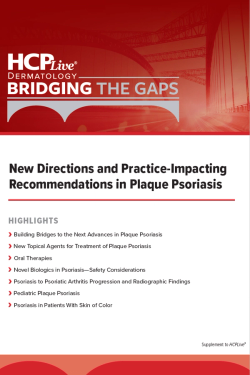Psoriasis to Psoriatic Arthritis Progression and Radiographic Findings
This publication was developed independently by MJH Life Sciences Global Medical Affairs. Support for the thought leaders meeting and the publication was provided by Arcutis Biotherapeutics, Inc; The Bristol Myers Squibb Company; Janssen Global Services, LLC; and UCB, Inc.
Psoriatic arthritis(PsA) is a heterogenous disease associated with psoriasis (PsO) and marked by chronic erosive inflammatory arthritis. Imaging results can aid in diagnosis, but a lack of specific diagnostic tests coupled with nonspecific arthritis symptoms can render diagnosis a challenge. Several risk factors for the progression of PsO to PsA have been identified, including a PsA family history and PsO of the nails, scalp, or genital/intertriginous areas. Greater body surface area affected by PsO may also increase the likelihood of PsA. Obesity, current smoking status, and prior trauma at entheses have also been associated with a greater risk for the development of PsA. Patients with PsO may present with other symptoms (eg, uveitis, arthralgias, enthesitis) that may prompt aclinician to suspect early PsA.1 The diverse presentation of PsA underscores the importance of asking patients about possible PsA symptoms and screening them for risk factors.
Radiographic Progression to Measure Structural Damage
Historically, clinical trials have focused on inhibition of radiographic progression as the preferred outcome measure for changes in structural damage. PsA is characterized by 6 different domains, thereby making it a phenotypically heterogeneous disease. Axial involvement occurs in approximately 25% to 70% of patients with PsA, depending on the definition of axial disease used; generally 30% is deemed to be the standard axial PsA involvement.2 However, the Sharp-van der Heijde modified scoring method for PsA, which accounts for changes in erosion and joint narrowing and other assessments of structural damage, does not include axial disease.3 Patients who have changes in joint space narrowing and erosions as shown on x-ray results should receive an agent that has demonstrated inhibition of radiographic progression. Patients who do not have erosive disease or joint space narrowing can receive any medication approved for use in PsA.
Treatment of PsA
The results of several studies suggest that use of disease-modifying antirheumatic drugs, biologics, and other systemic therapies to treat PsO that also are effective against PsA may decrease the risk of PsA development; however, these studies are limited by their retrospective nature.1 By the time a patient receives a diagnosis of PsA and starts systemic therapy, there may have been irreversible joint damage, especially if changes were noted on x-ray imaging. A substantial unmet need remains to diagnose PsA early before irreversible joint damage has set in. Further research is also needed to assess the impact of early therapy in patients with PsO who may progress to PsA, including prospective studies that compare biologic therapies, agents with different mechanisms of action, and different types of treatment (eg, biologics versus oral small molecules versus topicals versus phototherapy). For example, the PAMPA study (NCT05004727) is a prospective study underway to assess the efficacy of the interleukin [IL]-23 inhibitor guselkumab, in preventing PsA in an at-risk population of patients with PsO.4
In a recent retrospective study, data from electronic health records in a national database were used to determine the risk of developing PsA among patients with PsO who were receiving biologic therapy. Patients with PsO who were given an IL-23 blocker had fewer diagnoses of inflammatory arthritis or PsA.5 These data, while limited, suggest that perhaps early intervention may change the downstream immunologic milieu, thereby preventing or delaying the time to a PsA diagnosis.
Conclusions
Any patient with PsO who has new onset of arthralgias, including a complaint of joint pain or achiness, should be considered at risk for PsA. Dermatologists who suspect that a patient with PsO has PsA should initiate appropriate therapy to treat both conditions if they feel comfortable and especially if the patient has moderate to severe PsO. Patients who have PsA may begin to respond to treatment. If treatment is inadequate, rheumatologists can modify therapy for the best possible outcome. Dermatologists who are not comfortable making a diagnosis of PsA should refer such patients to a rheumatologist, who can confirm a diagnosis of PsA and lend their expertise.
Faculty presenter: Saakshi Khattri, MD. This article was reviewed, edited, and approved by Dr Khattri and Dr Stein Gold.
References
- Gisondi P, Bellinato F, Maurelli M, et al. Reducing the risk of developing psoriatic arthritis in patients with psoriasis. Psoriasis (Auckl). 2022;12:213-220. doi:10.2147/PTT.S323300
- Giovannini I, Zabotti A, Ciccio C, et al. Axial psoriatic disease: clinical imaging assessment of an underdiagnosed condition. J Clin Med. 2-21;10(13):2845. doi:10.3390/jcm10132845
- van der Heijde D, Sharp J, Wassenberg S, Gladman DD. Psoriatic arthritis imaging: a review of scoring methods. Ann Rheum Dis. 2005;64 (suppl 2):ii61-ii64. doi:10.1136/ard.2004.030809
- Haberman RH, MacFarlane KA, Catron S, et al. Efficacy of guselkumab, a selective IL- 23 inhibitor, in Preventing Arthritis in a Multicentre Psoriasis At-Risk cohort (PAMPA): protocol of a randomised, double-blind, placebo controlled multicentre trial. BMJ Open. 2022;12(12):e063650. doi:10.1136/bmjopen-2022-063650
- Singla S, Putman M, Liew J, Gordon K. Association between biological immunotherapy for psoriasis and time to incident inflammatory arthritis: a retrospective cohort study. Lancet Rheumatol. 2023;5(4):e200-e207. doi:10.1016/S2665-9913(23)00034-6
- Zabotti A, De Marco G, Gossec L, et al. EULAR points to consider for the definition of clinical and imaging features suspicious for progression from psoriasis to psoriatic arthritis. Ann Rheum Dis. 2023;82(9):1162-1170. doi:10.1136/ard-2023-224148

